The following is an excerpt from "The Lives of the Most Eminent Painters, Sculptors & Architects, Vol. IX" by Giorgio Vasari, orginally published in 1550:
When the Pope had returned to Rome and Michelagnolo was at work on the statue, Bramante, the friend and relative of Raffaello da Urbino, and for that reason little the friend of Michelagnolo, perceiving that the Pope held in great favour and estimation the works that he executed in sculpture, was constantly planning with Raffaello in Michelagnolo's absence to remove from the mind of his Holiness the idea of causing Michelagnolo, after his return, to devote himself to finishing his tomb; saying that for a man to prepare himself a tomb during his own lifetime was an evil augury and a hurrying on of his death. And they persuaded his Holiness that on the return of Michelagnolo, he should cause him to paint in memory of his uncle Sixtus the vaulting of the chapel that he had built in the Palace. In this manner it seemed possible to Bramante and other rivals of Michelagnolo to draw him away from sculpture, in which they saw him to be perfect, and to plunge him into despair, they thinking that if they compelled him to paint, he would do work less worthy of praise, since he had no experience of colours in fresco, and that he would prove inferior to Raffaello, and, even if he did succeed in the work, in any case it would make him angry against the Pope; so that in either event they would achieve their object of getting rid of him. And so, when Michelagnolo returned to Rome, the Pope was not disposed at that time to finish his tomb, and requested him to paint the vaulting of the chapel. Michelagnolo, who desired to finish the tomb, believing the vaulting of that chapel to be a great and difficult labour, and considering his own want of practice in colours, sought by every means to shake such a burden from his shoulders, and proposed Raffaello for the work. But the more he refused, the greater grew the desire of the Pope, who was headstrong in his undertakings, and, in addition, was being spurred on anew by the rivals of Michelagnolo, and especially by Bramante; so that his Holiness, who was quick-tempered, was on the point of becoming enraged with Michelagnolo. Whereupon Michelagnolo, perceiving that his Holiness was determined in the matter, resolved to do it; and the Pope commanded Bramante to erect the scaffolding from which the vaulting might be painted. Bramante made it all supported by ropes, piercing the vaulting; which having perceived, Michelagnolo inquired of Bramante how he was to proceed to fill up the holes when he had finished painting it, and he replied that he would think of that afterwards, and that it could not be done otherwise. Michelagnolo recognized that Bramante was either not very competent for such a work or else little his friend, and he went to the Pope and said to him that the scaffolding was not satisfactory, and that Bramante had not known how to make it; and the Pope answered, in the presence of Bramante, that he should make it after his own fashion. And so he commanded that it should be erected upon props so as not to touch the walls, a method of making scaffoldings for vaults that he taught afterwards to Bramante and others, whereby many fine works have been executed. Thus he enabled a poor creature of a carpenter, who rebuilt the scaffolding, to dispense with so many of the ropes, that, after selling them (for Michelagnolo gave them to him), he made up a dowry for his daughter.
He then set his hand to making the cartoons for that vaulting; and the Pope decided, also, that the walls which the masters before him in the time of Sixtus had painted should be scraped clean, and decreed that he should have fifteen thousand ducats for the whole cost of the work; which price was fixed through Giuliano da San Gallo. Thereupon, forced by the magnitude of the undertaking to resign himself to obtaining assistance, Michelagnolo sent for men to Florence; and he determined to demonstrate in such a work that those who had painted there before him were destined to be vanquished by his labours, and also resolved to show to the modern craftsmen how to draw and paint. Having begun the cartoons, he finished them; and the circumstances of the work spurred him to soar to great heights, both for his own fame and for the welfare of art. And then, desiring to paint it in fresco-colours, and not having any experience of them, there came from Florence to Rome certain of his friends who were painters, to the end that they might give him assistance in such a work, and also that he might learn from them the method of working in fresco, in which some of them were well-practised; and among these were Granaccio, Giuliano Bugiardini, Jacopo di Sandro, the elder Indaco, Agnolo di Donnino, and Aristotile. Having made a commencement with the work, he caused them to begin some things as specimens; but, perceiving that their efforts were very far from what he desired, and not being satisfied with them, he resolved one morning to throw to the ground everything that they had done. Then, shutting himself up in the chapel, he would never open to them, nor even allowed himself to be seen by them when he was at home. And so, when the jest appeared to them to be going too far, they resigned themselves to it and returned in shame to Florence. Thereupon Michelagnolo, having made arrangements to paint the whole work by himself, carried it well on the way to completion with the utmost solicitude, labour, and study; nor would he ever let himself be seen, lest he should give any occasion to compel him to show it, so that the desire in the minds of everyone to see it grew greater every day.
Pope Julius was always very desirous to see any undertakings that he was having carried out, and therefore became more eager than ever to see this one, which was hidden from him. And so one day he resolved to go to see it, but was not admitted, for Michelagnolo would never have consented to show it to him; out of which affair arose the quarrel that has been described, when he had to depart from Rome because he would not show his work to the Pope. Now, when a third of the work was finished (as I ascertained from him in order to clear up all doubts), it began to throw out certain spots of mould, one winter that the north wind was blowing. The reason of this was that the Roman lime, which is made of travertine and white in colour, does not dry very readily, and, when mixed with pozzolana, which is of a tawny colour, makes a dark mixture which, when soft, is very watery; and when the wall has been well soaked, it often breaks out into an efflorescence in the drying; and thus this salt efflorescence of moisture came out in many places, but in time the air consumed it. Michelagnolo was in despair over this, and was unwilling to continue the work, asking the Pope to excuse him, since he was not succeeding; but his Holiness sent Giuliano da San Gallo to see him, and he, having told him whence the defect arose and taught him how to remove the spots of mould, encouraged him to persevere.
Now, when he had finished half of it, the Pope, who had subsequently gone to see it several times (mounting certain ladders with the assistance of Michelagnolo), insisted that it should be thrown open, for he was hasty and impatient by nature, and could not wait for it to be completely finished and to receive, as the saying is, the final touch. No sooner was it thrown open than all Rome was drawn to see it, and the Pope was the first, not having the patience to wait until the dust caused by the dismantling of the scaffolding had settled. Thereupon Raffaello da Urbino, who was very excellent in imitation, after seeing it straightway changed his manner, and without losing any time, in order to display his ability, painted the Prophets and Sibyls in the work of the Pace; and at the same time Bramante sought to have the other half of the chapel entrusted by the Pope to Raffaello. Which hearing, Michelagnolo complained of Bramante, and revealed to the Pope without any reserve many faults both in his life and in his architectural works; of which last, in the building of S. Pietro, as was seen afterwards, Michelagnolo became the corrector. But the Pope, recognizing more clearly every day the ability of Michelagnolo, desired that he should continue the work, judging, after he had seen it uncovered, that he could make the second half considerably better; and so in twenty months he carried that work to perfect completion by himself alone, without the assistance even of anyone to grind his colours. Michelagnolo complained at times that on account of the haste that the Pope imposed on him he was not able to finish it in his own fashion, as he would have liked; for his Holiness was always asking him importunately when he would finish it. On one occasion, among others, he replied, "It will be finished when I shall have satisfied myself in the matter of art." "But it is our pleasure," answered the Pope, "that you should satisfy us in our desire to have it done quickly;" and he added, finally, that if Michelagnolo did not finish the work quickly he would have him thrown down from the scaffolding. Whereupon Michelagnolo, who feared and had good reason to fear the anger of the Pope, straightway finished all that was wanting, without losing any time, and, after taking down the rest of the scaffolding, threw it open to view on the morning of All Saints' Day, when the Pope went into the chapel to sing Mass, to the great satisfaction of the whole city. Michelagnolo desired to retouch some parts "a secco," as the old masters had done on the scenes below, painting backgrounds, draperies, and skies in ultramarine, and ornaments in gold in certain places, to the end that this might produce greater richness and a more striking effect; and the Pope, having learned that this ornamentation was wanting, and hearing the work praised so much by all who had seen it, wished him to finish it; but, since it would have been too long a labour for Michelagnolo to rebuild the scaffolding, it was left as it was. His Holiness, often seeing Michelagnolo, would say to him that the chapel should be enriched with colours and gold, since it looked poor. And Michelagnolo would answer familiarly, "Holy Father, in those times men did not bedeck themselves with gold, and those that are painted there were never very rich, but rather holy men, on which account they despised riches."
For this work Michelagnolo was paid by the Pope three thousand crowns on several occasions, of which he had to spend twenty-five on colours. The work was executed with very great discomfort to himself, from his having to labour with his face upwards, which so impaired his sight that for a time, which was not less than several months, he was not able to read letters or look at drawings save with his head backwards. And to this I can bear witness, having painted five vaulted chambers in the great apartments in the Palace of Duke Cosimo, when, if I had not made a chair on which I could rest my head and lie down at my work, I would never have finished it; even so, it has so ruined my sight and injured my head, that I still feel the effects, and I am astonished that Michelagnolo endured all that discomfort so well. But in truth, becoming more and more kindled every day by his fervour in the work, and encouraged by the proficience and improvement that he made, he felt no fatigue and cared nothing for discomfort.


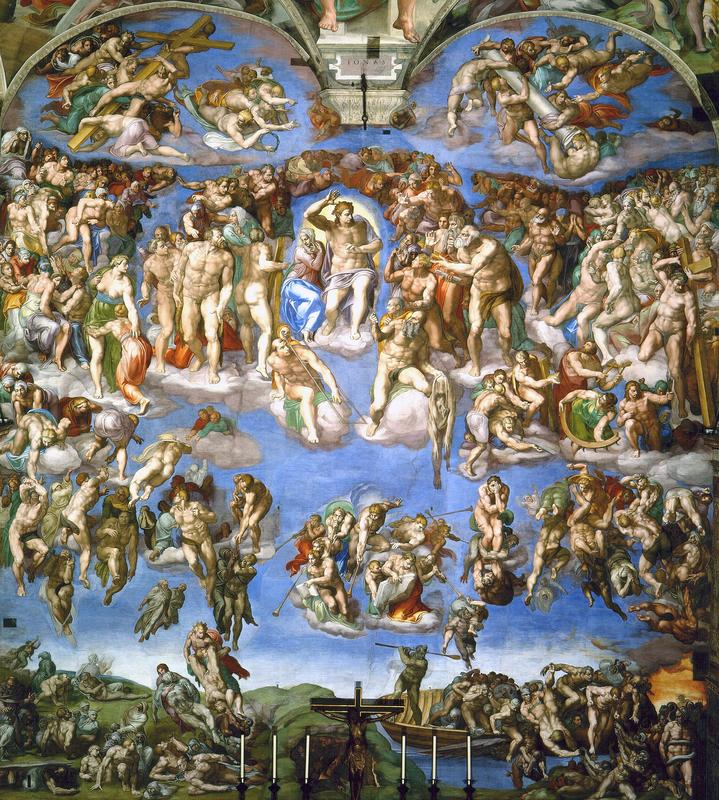
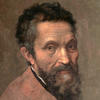
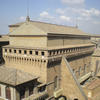
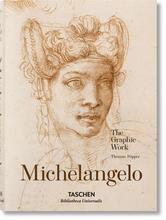
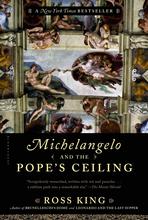
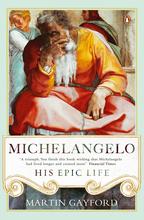
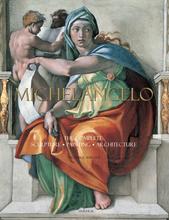
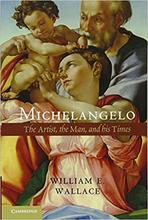
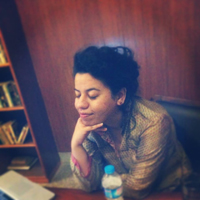













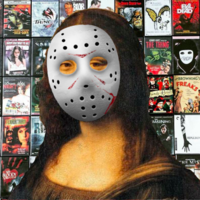
The painter put the two plots of Adam and Eve eating the forbidden fruit and their expulsion from the Garden of Eden on one painting. The tree of wisdom was used in the middle to separate the two plots. The composition was balanced and coordinated.